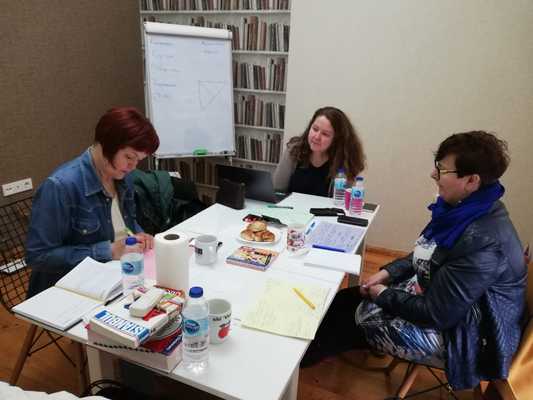4. dan - 12. ožujka 2020.
Na početku dana edukatorica nas je informirala o glavnoj temi: kritičko mišljenje i Bloom-ova taksonomija.
Zadala nam je zadatak da predvidimo o čemu ćemo danas razgovarati na zadanu temu, zatim što će nam biti od koristi i što nam neće biti interesantno.
U sljedećoj aktivnosti pogledali smo nijemi video o kratkoj ljubavnoj priči sa zadatkom da je opišemo. Bio je to uvod u raspravu o kritičkom mišljenju kao sposobnosti jasnog i racionalnog razmišljanja o tome što učiniti ili što vjerovati. Uključuje i sposobnost refleksivnog i nezavisnog mišljenja. Karakteristike kritičkog mišljenja jesu: razmišljanje o opravdanosti nečijih vlastitih vjerovanja i vrijednosti, detektiranje nedosljednosti i čestih pogrešaka u obrazloženju, pronalaženje, konstruiranje i evaluiranje argumenata, razumijevanje logične povezanosti među idejama, rješavanje problema sustavno i identificiranje relevantnosti i važnosti ideja.

Koristan zadatak za učenike može biti da završe priču na drugačiji način ili s drugačijim karakterima. Nadalje, učenicima možemo pročitati iskrivljenu verziju viđenog videa (viđenog filma, pročitane priče) sa zadatkom da usporede te dvije verzije. Isto tako, možemo im dati listu rečenica koje trebaju svrstati u „činjenice“ i „mišljenje“.
Na kraju dana naglasili smo karakteristike učiteljskog posla koje doprinose povećanju kreativnosti, većoj dinamici u radu, zanimljivosti i boljem pamćenju sadržaja.
Day 4 - 12th March 2020.
At the beginning of the day, the educator informed us about the main topic: critical thinking and Bloom's taxonomy.
It has given us the task of predicting what we will discuss today on a given topic, then what will be of use to us and what will not be of interest to us.
In the next activity, we watched a silent video of a short love story with the task of describing it. It was an introduction to the discussion of critical thinking as the ability to think clearly and rationally about what to do or what to believe. It also includes the ability to think reflectively and independently.
The characteristics of critical thinking are: thinking about the justification of one's own beliefs and values, detecting inconsistencies and frequent errors in reasoning, finding, constructing and evaluating arguments, understanding the logical connection between ideas, solving problems systematically, and identifying the relevance and importance of ideas.
A useful task for students may be to complete the story in a different way or with different characters. Furthermore, we can read to students a distorted version of a video seen (movie seen, story read) with the task of comparing the two versions. Likewise, we can give them a list of sentences to classify as "facts" or "opinions."
At the end of this very interesting day, we emphasized the characteristics of a teaching job that contribute to increased creativity, greater dynamic in work, more interesting and better memory of the school’s content.